 BY LEE VAN DER VOO
BY LEE VAN DER VOO
The catch-share fisheries management system is designed to boost wild fish stocks. Will the new program leave fishermen adrift?
BY LEE VAN DER VOO | PHOTOS BY JOSEPH EASTBURN*
*CHESTNUT AND LAPHAM PHOTOS BY LEE VAN DER VOO
The catch-share fisheries management system is designed to boost wild fish stocks. Will the new program leave fishermen adrift?
Gangion Lapham is 4 years old. And when you’re 4 and your dad owns a 66-foot combination boat, the Michele Ann, your world is a life-sized jungle gym. You speed through the traps on the deck, ferrying messages to the crew. You sit in the captain’s chair and whisper to yourself. You jump ladders, reverse course, dive down and poke your head in the galley windows.
Life on a boat is pretty good. When you’re 4. When you’re 40. When you’re 71. This generation gap means more than it used to, however. Gangion Lapham was born a year and a half before policy radically remade Pacific groundfishing (fishing for cod, haddock and other predators that live on or near the ocean floor). As those changes retool the industry, it’s hard to say whether life on this boat will one day be as good for him as it has been for his father.
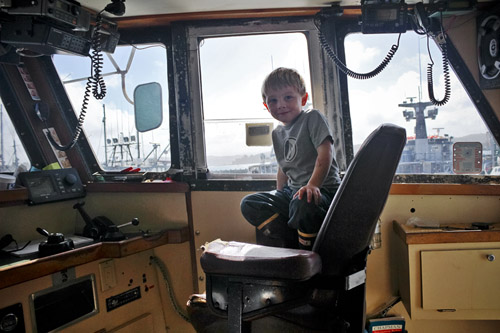 |
| Four-year-old Gangion Lapham aboard the Michele Ann. |
The Michele Ann hails from Newport. It’s a powerhouse in the groundfish industry, sales of which garnered $54 million on the West Coast in 2011. The trawl boats that rule this sector, giant draggers with steel gates and huge nets hanging from the rear, were the targets of recent changes. Too many and too deadly, they were squeezed from 274 to 183 in 2003 to ease the pressure on fish. Over the past three years, in an effort to move it to a more sustainable fishing model, their industry has been slowly remade from one for seafaring entrepreneurs into a commodities market, one in which boats like the Michele Ann, formerly ascribed separate rules, can now play.
This is the new face of oceanic environmentalism: catch shares. It’s an aquatic revolution on a scale the U.S. has never seen. Catch shares aim to convert fisheries to sustainable fishing by capping the amount of fish that can be caught and awarding the rights to fish them, called a quota, to stakeholders, unless those stakeholders choose to sell it. In this case, fishermen and processors share the bounty, save for a tiny set-aside for research. The downside is that, as privatization becomes the policy path to seafood salvation in America, the costs of fishing are rising dramatically. As a result, groundfishing could evolve from a small business to a wage job. And in a generation or two, that could ultimately place control of a natural resource in the hands of big business and private equity firms.
The dryly dubbed Pacific Coast Groundfish Trawl Rationalization, as this catch share is called, has put 64 kinds of rockfish, 12 flatfish like lingcod, six roundfish and others in the hands of private citizens and corporations. The rules they now play by reach 200 miles into the sea from the southern tip of California to the north end of Washington. Mirroring similar programs in Alaska for pollack and crab (think Filet-O-Fish sandwiches and The Deadliest Catch), to the iconic cod industry of New England, this is the 15th program of its kind in the U.S. All told, these catch shares control more than 50% of the value of domestic seafood.
The catch-share program’s success in protecting species that used to be collateral damage in groundfishing is striking. Bycatch — or accidental catch — has gone from 20% or 25% to 4.8% of the total haul from the seafloor. In just 36 months, West Coast fishermen have proven catch sharing can indeed be the environmental boon its advocates tout. Some fishermen have fared wonderfully in this equation, running more predictable, profitable and sustainable seafood businesses.
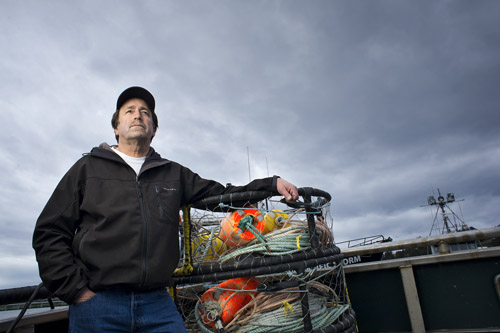 |
| Bob Eder bought his way into fishing in the 1970s. |
In three years on the West Coast, however, catch shares have also squeezed the number of boats that can go fishing, and divided fishermen into the ones who own the right to go to sea and the ones who rent it. Some fishermen don’t fish at all anymore, instead doling out their quotas to intrepid young workers at a price. That trend has some longtime fishermen worried.
“I’ve seen the fleet go from where virtually every boat represented one family business … to now where some processors and other entities control significant fleets and hold large amounts of quota in groundfish. Now anyone, regardless of fishing-industry history or sweat equity, can own quota,” says Bob Eder, a Newport fisherman, commenting on purchasing trends as some fishermen sell.
He says the catch share has opened up new opportunities for his business aboard the Timmy Boy, owing to incentives that allow trawlers to use traps instead of nets to promote cleaner fishing methods with less bycatch. That makes it possible for trap boats like his to participate and catch more fish, if they also own trawl permits, a separate license required to fish in the catch-share system.
Despite his success, Eder is concerned about harvesters eventually fading as owners. “We may become more like jobbers or sharecroppers,” he says. “This is disturbing, particularly the tall challenge it could create for a next generation of fishermen to become owner/operators. Much capital is required to acquire not just the boat but the permits, and, most critically, the quota.”
It used to be that anybody could play in this industry. You got a boat. You got a net. You took to the sea and went fishing, dragging the seafloor for fish to sell on the docks. There were too many boats this way, though. And not enough fish. So the outcome was what anybody could have predicted: too much slippery carnage. In 2003 regulators from the National Marine Fisheries Service (NMFS) sought to contain it by buying 91 of the boats. There was still too much carnage. By 2010 they were opening a new season every two months, setting firm caps on what could be caught in each. Fishermen did what anybody does in that scenario: They rushed to catch as much as they could before regulators cut them off. They also developed a habit of throwing back the too-small fish, keeping the bigger ones that sold better and leaving a lot of blood in the water. No surprise that this management method didn’t work either.
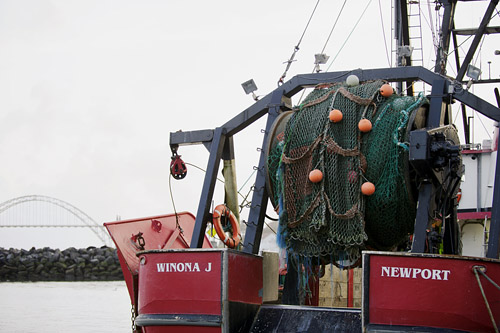 This is the mess that catch shares contained. As an environmental tool, catch shares have proven highly effective for Pacific groundfish. For fishermen who received quota in the system and continue to fish, they’ve also made fishing more predictable and, thus, safe. No one rushes to the sea to quickly catch as much as they can anymore, regardless of weather. The branding that comes with fishing cleaner and the power of ownership has also boosted prices for groundfish, making the jobs that remain better paying than before.
This is the mess that catch shares contained. As an environmental tool, catch shares have proven highly effective for Pacific groundfish. For fishermen who received quota in the system and continue to fish, they’ve also made fishing more predictable and, thus, safe. No one rushes to the sea to quickly catch as much as they can anymore, regardless of weather. The branding that comes with fishing cleaner and the power of ownership has also boosted prices for groundfish, making the jobs that remain better paying than before.
Think of catch share as a cap-and-trade system for fish; just as regulators commoditize greenhouse gases in the hopes that market forces will limit emissions, catch share allows anyone to buy and sell fishing quota, with the goal of improving wild-fish stocks.
Pacific hake, also called whiting, the most abundant commercial fish on the West Coast, is especially profitable this way, making up the flaky innards of imitation crab and other processed white-meat products. Whiting fishermen landed $20.3 million in product last year, dwarfing their pre catch share high of $6.7 million. Such rising values explain why guys like Riley Holt, a crewman on the Winona J, is buying his second house at age 27. When he started fishing, Holt earned $60,000 a year but has made roughly $90,000 annually under the catch share, working for a fishing family that owns quota
Brad Pettinger, director of the Oregon Trawl Commission, says stories like Holt’s — a satisfied young worker with a stable job for his wife and child on the way — are a world away from the tales of the old system. Today the biggest complaint whiting fishermen have about the industry is that it’s difficult to find quota and get in. By contrast, Pettinger remembers a California fisherman who tried to sell his boats and permits before talk of a catch share began. He went more than a year without a phone call — nobody was even curious about buying his business. Groundfish was too shaky an investment in the old system, where it was impossible to know how much fish a boat could catch and the fishing rules seemed to be constantly changing.
“That’s how bad things were. It really puts things in perspective as far as everybody complaining that it’s difficult to get into this fishery,” says Pettinger, who owns a hake boat and quota that is now managed by his brother, but whoknows too well the pains of the old system. “I’ve been in both fisheries. I’ve been in one that’s doing fairly well, and I’ve been in one that sucks. I never want to go back to one that sucks. I’d much rather be in a fishery that everybody would like to get into and can’t than one where anybody can get into and doesn’t.”
Pacific hake is now hovering on the edge of a sustainability certification from the Marine Stewardship Council, something that’s likely to pitch values further upward.
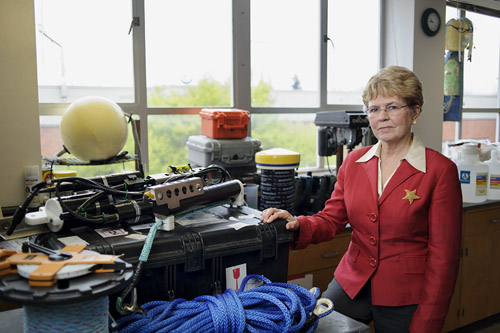 |
| Dr. Jane Lubchenco is the former administrator of the NOAA and a catch-share proponent. |
This kind of outcome is what catch-share proponents hoped for. “The goal here is to have healthy oceans and have healthy and profitable fisheries, and to get us out of what has been a downward spiral that has meant fewer and fewer fish and crumbier and crumbier fishing jobs … to a more profitable, more sustainable fishery and a healthy ocean,” says Dr. Jane Lubchenco. An environmental scientist and marine ecologist at Oregon State University, she is the former head of the National Oceanic and Atmospheric Administration. She’s spent much of her career exploring catch shares. In 2010 she presided over the adoption of a new national policy that urges regulators to consider catch shares when making fishery-management plans, a coup for sustainable seafood.
She acknowledges the Pacific program is not perfect. Few catch shares are. “But it is one that many fishermen have said is light years better than it used to be.”
Even Georgon Lapham has so far prospered in the new program. The man ubiquitously known as Poggy is not an obvious winner. He’s not a quota holder; he’s a new entrant. Yet he feels lucky. Lapham is the new owner of the Michele Ann. Like Eder’s boat, it’s one that has a long history fishing sablefish, and Lapham was able to increase its catch by jumping into the catch share. After it began, he started leasing a trawl permit for about $10,000 a year, a move that makes the boat eligible to participate.
Lapham’s experience, however, illustrates why some observers of the catch share are concerned it will convert fishing from a small-business venture to a wage job.
Now, Lapham pays between $600,000 and $700,000 a year to fish in the catch share, or about 35% off the top of his revenue. This is rent, basically, payments made to roughly 20 different quota holders so he can catch their share of fish.
Many people Lapham rents from are whiting fishermen whose nonwhiting quota is up for grabs. The other quota holders he rents from, however — about half — are former fishermen who can earn just as much money leasing their quota as they can fishing. Once the costs are considered — fishermen traditionally shoulder the costs of boat maintenance, insurance, crew pay, bait, ice, food and fuel to get to the fishing grounds 18-miles away — renting quota is a break even and sometimes money-making prospect when compared to going fishing at all. Many former fishermen now prefer to stay home.
This is the trend that worries the likes of Eder. In a scenario where guys like Lapham prop up the industry’s retirees, it’s unlikely Lapham will own quota, at least not anytime soon. It wasn’t awarded to him — he wasn’t eligible because he didn’t own a trawl permit. And the rental economy is lucrative enough that there isn’t any for sale. Instead, Lapham operates on a tight budget to make payments on the boat and leases as well as cover expenses and his crew of five.
He isn’t complaining. “I’m extremely thankful that we are able to enter into the trawl program,” he says, adding that by doing so, even as a renter, he can catch five times the amount of fish he could otherwise. “I’ve never not leased, I’ve only ever leased. So I haven’t been spoiled, I guess.”
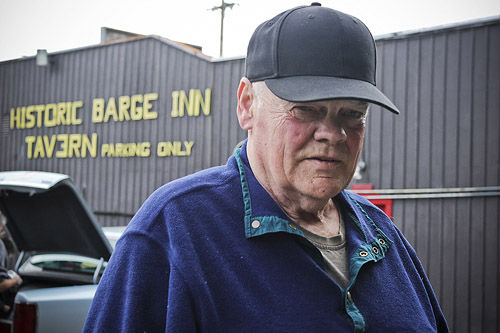 |
Ben Chestnut drinks coffee in the Barge Inn most days, often joined by |
Some guys are spoiled, though. They remember when nobody took 35% off the top of their earnings just so they could go fishing. And they recall when fishermen weren’t angling to capture the upside of the next generation’s labor.
Ben Chestnut is one of those guys. He left trawling in 2011 after decades as a boat captain, after the boats he worked on were sold and traded, and he didn’t have the money to enter the catch share as an owner. “The bottom line is I got put out of the fishery because I didn’t have enough money to buy a permit,” says Chestnut, noting his son fetched $535,000 for a permit at that time.
Now 71, he drives wastewater trips from a surimi processor to the Pacific. He spends some of the rest of his time drinking coffee at the Barge Inn, a woodsy tavern in Newport’s downtown that faces the whale on the mural of the Pacific Seafood plant. The plant has its own share of quota, awarded since the catch share was created. Since then, the company has purchased roughly a dozen boats and their quota, amassing a small fleet.
“I look for big business to own all the fish eventually,” Chestnut says, observing that as the values of fish rise, quota values rise with it, making it easiest for businesses like processors, not individual fishermen, to acquire what quota comes on the market. “Nowadays with the permits, and the value of the permits and the value of the fish quota, you’d pay millions of dollars to buy them out.”
The notion isn’t just sour grapes. Catch shares have shrunk the number of fishermen working nationwide, and big business can and does swoop in for the largest assets. In the lucrative crab industry in Alaska, for example, 184 boats left the industry during and after its conversion to a catch share, even while the value of the crab climbed from $125 million in 2005 to today’s $202 million. It’s mostly quota owners who captured that upside, not crews that do the fishing. Before the catch share, fishing crews earned 35.7% of their revenue catching crab. Five years later, they earned 20.4%, primarily because of soaring rents.
Such rising values have combined with consolidating assets to open the door for big business and equity investors to move in. In the nation’s oldest catch share, for example — Atlantic quahog, denizen of the canned clam — 49% of boats have disappeared since the catch share took hold in 1990. Thirty years later, a quarter of the quota sold to British private-equity firm Lion Capital in a deal for Bumble Bee Foods. Bumble Bee acquired it with the prior purchase of its subsidiary Snow’s, the clam chowder king.
 Early signs of consolidation are apparent in Pacific groundfish. Of 118 trawl vessels that were active in 2011, when the catch share began, 105 vessels fished in 2012, a number that’s likely to decline as more quota owners switch from fishing to renting. Today rules make it possible for anyone — even a banker from Kansas City or another large equity fund — to own the Pacific groundfish quota. While it’s impossible to say where the trend will lead, it’s one that causes concern.
Early signs of consolidation are apparent in Pacific groundfish. Of 118 trawl vessels that were active in 2011, when the catch share began, 105 vessels fished in 2012, a number that’s likely to decline as more quota owners switch from fishing to renting. Today rules make it possible for anyone — even a banker from Kansas City or another large equity fund — to own the Pacific groundfish quota. While it’s impossible to say where the trend will lead, it’s one that causes concern.
What is clear, however, is that the catch share comes with built-in bottlenecks and economic challenges that will make it tough for some fishermen to stay in the industry as it transitions.
Some groundfish boats haven’t fared as well as the whiting operations, which are seeing the value of that product rise, or new entrants like Lapham and Eder, who are augmenting existing, successful portfolios by fishing in the catch share. For those fishing other groundfish like perch or Dover and petrale sole, fishing is now a lot like playing Jenga: One wrong move and the whole enterprise can topple.
There are 206 million pounds of whiting quota, but only 169 million pounds of quota for all other species of groundfish combined. As skipper Wade Hearne tells it, if you catch more than your share, particularly of certain species, it’s game over. That sounds easier to manage than it really is. Hearne’s painting knot dips on the nets aboard the Last Straw while he explains how the boat — his father’s — has a “ton of quota” for the Dover sole it catches. But because the boat drags the bottom, and because the catch share is built to reduce impacts on fish typically hit hard by dragging, quota is in short supply in eight species that might be caught up in the nets. Bocaccio, cowcod, petrale sole, Pacific perch, and yelloweye, widow, canary and darkblotched rockfish are all struggling.
“The amount of quota is not enough for it to really support the industry where it’s a bycatch,” says Hearne. For this reason, quota of these species rent, not at less than what you could sell a fish at the dock for, but for the kind of costly price people pay for insurance policies. “If you go out to lease it, you’re going to be leasing it for more than what the plant pays for it. You’re buying it not for profit but to keep your risks down and stay within the rules.”
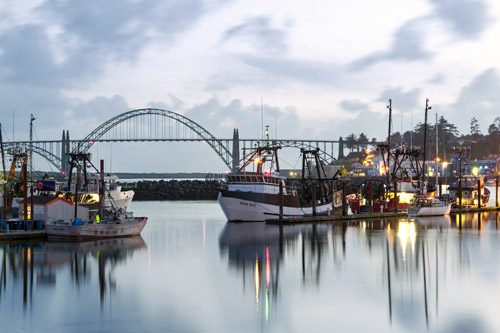 Aboard the nearby Western Breeze, twins Kenny and Randy Ripka say they have seen just two pounds of yelloweye fetch $500. The price demonstrates how the leasing market may squeeze fishermen in the system, some already working on narrow margins.
Aboard the nearby Western Breeze, twins Kenny and Randy Ripka say they have seen just two pounds of yelloweye fetch $500. The price demonstrates how the leasing market may squeeze fishermen in the system, some already working on narrow margins.
And the catch share has added costs. Fishermen now pay 1.5% of their revenue to NMFS to administer the catch share, plus 3% toward management and 5% to finance the cost of the 2003 boat buyback. They also pay $230 a day for human observers — most trips take five days — to make each boat accountable, resolving the problem of throwing back the too-small fish. Many of these are new costs. They’re a squeeze on any operation but are particularly hard on the less lucrative operations fishing nonwhiting groundfish.
“I think if shrimp weren’t so good right now, we’d be feeling it,” says Kenny Ripka, explaining the challenges have combined with the rising costs of the catch share to steer the Western Breeze to shrimp and crab instead.
And yet this squeeze works for conservation. Trawl fishermen see their environmental gains and take pride in them — even renters like Lapham, who, in spite of paying out 35% of his revenue to go fishing, has found a stable, profitable place in this industry as it shifts. Yet he knows what it took for him to buy in. And he knows it’s bound to get more expensive as values rise.
Looking at his son, Gangion, leaping after a crewman aboard the Michele Ann, he wonders if the good fortune he has enjoyed will be within reach for those who come next.
“That’s him,” he says. “He might not be a fisherman, I’m not going to try and make him be a fisherman. But like the guys who work for me — they’re all great guys and they are all perfectly capable of running their own vessels, but how can they even begin to try and afford it?”
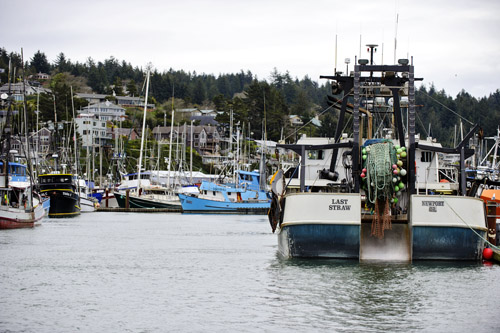 Aaron Longston fishes black cod as a hook and line fishermen and hails from the small boat fleet in Port Orford. He isn’t allowed to own quota under the new trawl program – access is restricted to boats that own trawl permits. Since the trawl program began, however, guys like Longston have had to share their fishing grounds between 100 fathoms and 200 fathoms with larger trawl boats that have been allowed to switch to fixed gear, like the Michele Ann and Timmy Boy. Those boats can now come inside the 200 fathom line.
Aaron Longston fishes black cod as a hook and line fishermen and hails from the small boat fleet in Port Orford. He isn’t allowed to own quota under the new trawl program – access is restricted to boats that own trawl permits. Since the trawl program began, however, guys like Longston have had to share their fishing grounds between 100 fathoms and 200 fathoms with larger trawl boats that have been allowed to switch to fixed gear, like the Michele Ann and Timmy Boy. Those boats can now come inside the 200 fathom line.
“We’ve always been able to fish in there without the pressure of all that extra quota. Now with gear switching, they are right on top of us,” he said.
Port Orford’s unique location six miles from where groundfish are abundant, a 12-mile edge on ports like Newport and Astoria, help make it possible for small boats to be successful in the area. That’s good, because the port can’t handle larger boats. Because its vessels are actually hoisted into the water from a shipyard, they have a weight limit of roughly 43,000 pounds, a limit that excludes boats longer than 40 feet.
These are boats that used to be able to fetch higher prices, since line or pot caught black cod is worth more. But since the trawl program has put more such black cod on the market, lower prices have combined with the declining yen to make business tough.
As they grapple for an edge, community supported fisheries are a possible advantage. Longston is the manager of Port Orford Sustainable Seafood, where customers pay regularly for fresh fish deliveries. Modeled on a community supported farm, the CSF, as it’s called, is in its fifth year ferrying fish from Port Orford to the I-5 corridor. It drops fish in 13 locations. Three in Portland; one each in Salem, Corvallis, Roseburg and Bandon; and six in the Rogue Valley: Cave Junction, Grants Pass, Jacksonville, Ashland, Medford and Eagle Point.
Though the creators of the program say it was only fair that trawl fishermen be awarded rights consistent with their pre-program catch, Longston questions why, in a program where environmental gain was a primary goal, the door wasn’t left open for hook and line fishers to buy quota, especially when trawl boats now have access to their grounds.
As it stands, small boat fishermen can’t add more fish to their repertoire unless they buy a trawl permit. That’s off the table, Longston says. “You have to be millionaire to get in.”
NOAA is aware of the potential for conflicts. Frank Lockhart, the groundfish program manager in the Sustainable Fisheries Division of NOAA, says the council will likely address it in 2016, during a fifth-year review of the program.

